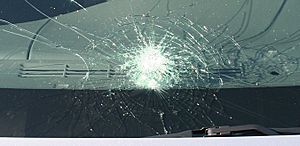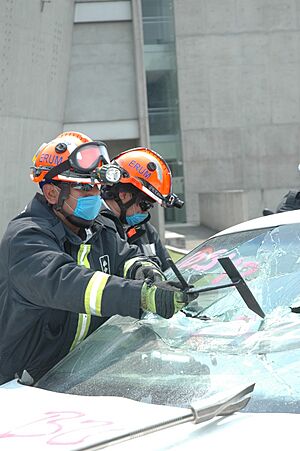Laminated glass facts for kids
Laminated glass is a special type of safety glass. It's made from two or more layers of glass with a thin plastic layer in between. This plastic layer stops the glass from breaking into big, sharp pieces if it gets hit. Instead, it usually cracks in a cool "spider web" pattern.
This strong glass is used in many places, like buildings, windows, and especially in car windshields. It's also great for blocking harmful UV rays from the sun and making rooms quieter by reducing noise. In places where hurricanes happen, laminated glass helps keep buildings safe.
The plastic layer is usually made of materials like PVB, EVA, or TPU. These plastics are super good at blocking almost all UV rays. Some types of plastic, like thermoset EVA, can block up to 99.9% of UV rays! This plastic also helps the glass stick together really well.
Contents
The Cool History of Laminated Glass
The idea for safer glass started a long time ago. In 1902, a French company found a way to coat glass with a material called celluloid to make it harder to break.
Then, in 1903, a French chemist named Édouard Bénédictus had an accident in his lab. He dropped a glass flask that had some plastic (cellulose nitrate) inside. The flask broke, but it didn't shatter into pieces! This gave him an amazing idea.
In 1909, after hearing about a car accident where people were hurt by glass, Bénédictus got a patent for his invention. By 1911, he started a company to make this new "Triplex" glass. It was a bit slow and expensive to make at first. But it became very important during World War I for gas masks.
Other inventors also worked on similar ideas. In 1905, John Crewe Wood in England patented laminated glass for car windshields, using a sticky substance called Canada balsam to hold the layers together.
A big improvement came in 1927 when Canadian chemists invented a new plastic called polyvinyl butyral (PVB). By 1936, companies in the United States found that using PVB in laminated glass made it even better. It didn't change color and was much harder to break through in accidents. This new safety glass quickly became the standard for cars.
By 1939, a huge amount of this safety glass was being used in cars, showing how important it had become for keeping people safe.
How Laminated Glass is Made
Modern laminated glass is made by sticking two or more layers of regular glass together. They use a special plastic layer in between, often made of PVB, TPU, or EVA. This plastic layer makes the glass much stronger and harder to break.
Here's how it generally works:
- The plastic layer is placed between the glass sheets.
- The whole "sandwich" then goes through rollers or a vacuum system to push out any air bubbles.
- Next, it's heated up to start melting the plastic.
- Finally, the glass is heated again under pressure in a special oven called an autoclave. This makes sure everything is perfectly bonded together.
You know that tinted strip at the top of some car windshields? That color is actually in the PVB plastic layer! You can also add colored plastic films to make the glass different colors.
Today, you can even print cool designs or pictures directly onto the plastic layer before it's laminated. This is popular for buildings, interior design, and signs, creating amazing colorful glass panels.
There's also something called LED glass. This is super cool! Since 2004, people have been putting tiny LED lights inside the plastic layers of laminated glass. This means the glass itself can light up! Imagine a window that's also a light source.
For LED glass, the layers look like this:
- Glass
- Clear plastic layer (like TPU, PVB, or EVA)
- LEDs on a clear, electricity-conducting plastic
- Another clear plastic layer
- Glass
Why Laminated Glass is So Good
Laminated glass offers many great benefits:
- Increased Safety and Security: If a car windshield made of laminated glass breaks, the glass pieces stick to the plastic layer. This stops sharp shards from flying around and hurting people inside the car. It also makes it much harder for intruders to break into buildings.
- Reduced Noise: This special glass is great at blocking sound. It can make rooms much quieter by reducing noise coming from outside.
- Energy Saving: Laminated glass can help block heat from the sun. This keeps buildings cooler, so you don't need as much air conditioning, which saves energy.
- Protection in Disasters: During natural disasters like hurricanes or earthquakes, laminated glass is less likely to shatter. This helps protect people and property.
Fixing Laminated Glass
If a laminated glass windshield gets a small crack or chip, it can often be repaired! Special clear glue is injected into the damaged area. Then, ultraviolet (UV) light is used to make the glue hard. When done right, this repair can make the glass strong and clear again, keeping it safe for driving.
Recycling Laminated Glass
It's important to recycle laminated glass. In many European countries, it's not allowed to just throw it away in landfills anymore. Scientists are working on ways to separate the glass from the plastic layer so both parts can be reused. One idea is to break the glass into small pieces and then melt the plastic layer, so the glass and plastic can be recycled separately. This helps protect our planet!
See also
- Toughened glass
- BS 857
- LED Film
- Composite glass
- Unbreakable glass



